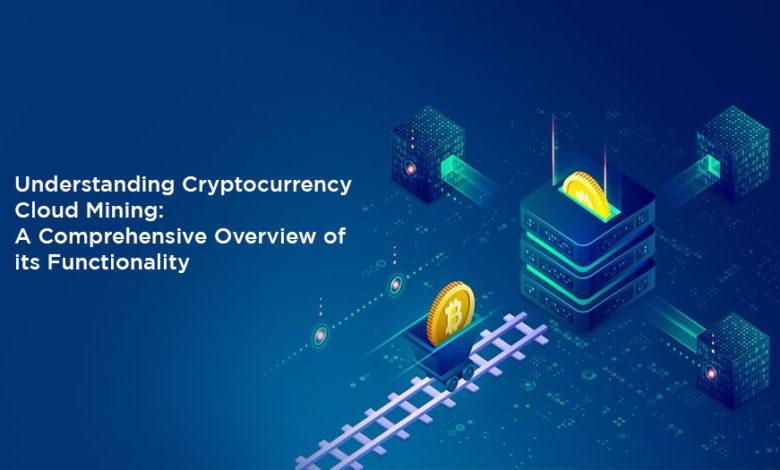Understanding Cryptocurrency Cloud Mining: A Comprehensive Overview of its Functionality

In the dynamic landscape of digital finance, the concept of cloud mining has emerged as a transformative force, revolutionizing the traditional approach to cryptocurrency acquisition. Cloud mining represents a mechanism where individuals harness the power of rented cloud computing resources to mine cryptocurrencies, most notably bitcoin, without the need for intricate hardware installations or direct operational involvement. This paradigm shift has not only democratized access to the complex world of cryptocurrency mining but has also ushered in a new era of global participation.
II. Cloud Mining Mechanics
In unraveling the intricate mechanics of cloud mining, a fundamental shift in traditional cryptocurrency acquisition methods becomes evident. Cloud mining operates as a decentralized mechanism where users leverage rented cloud computing power to engage in the complex process of cryptocurrency mining without the burden of physical hardware maintenance. This novel approach fosters a seamless and accessible entry point for individuals, democratizing participation in the ever-evolving landscape of digital assets.
Within the realm of cloud mining, users interface with specialized companies, opening accounts that serve as gateways to the expansive world of virtual mining. By transcending the need for direct operational involvement and intricate hardware setups, cloud mining offers a user-friendly pathway for enthusiasts and investors alike to partake in the creation of cryptocurrencies, prominently exemplified by the widely recognized bitcoin.
Mining pools form a pivotal aspect of cloud mining mechanics, where participants contribute to the collective computational power by acquiring specific “hash power.” This proportional contribution determines their share of the overall profits generated through the mining endeavors. The decentralized nature of cloud mining mitigates challenges associated with equipment maintenance and energy consumption, fostering a more sustainable and globally inclusive approach to cryptocurrency mining.
III. Key Takeaways
In distilling the essence of cloud mining, several key takeaways emerge, encapsulating the pivotal aspects that define its significance in the realm of cryptocurrency acquisition and participation.
Accessibility and Global Reach: Cloud mining stands as a gateway, transcending geographical boundaries and technical barriers. It empowers a diverse global audience by providing an accessible entry point into cryptocurrency mining without the need for intricate hardware setups.
Decentralization and Democratization: The decentralization inherent in cloud mining redefines the landscape of cryptocurrency creation. Through the elimination of direct operational involvement and hardware management, cloud mining democratizes the process, allowing individuals with varying levels of technical expertise to contribute to the mining ecosystem.
Mining Pool Dynamics: A cornerstone of cloud mining lies in the formation of mining pools. Participants, equipped with specific “hash power,” collaboratively engage in the mining process, earning a share of the profits commensurate with their contribution. This communal approach fosters a sense of collective achievement and distribution of rewards.
Advantages and Disadvantages: Cloud mining introduces a paradigm shift by reducing overall costs and enhancing accessibility for non-technical investors. However, it also brings forth challenges such as centralization concerns and vulnerability to market demand fluctuations, necessitating a nuanced understanding for potential participants.
IV. Understanding Cloud Mining
Delving into the core principles and dynamics of cloud mining unveils a paradigm shift in the traditional landscape of cryptocurrency acquisition. At its essence, cloud mining harnesses the power of cloud computing to facilitate. The production of blockchain-based cryptocurrencies, notably exemplified by the pioneering bitcoin. This innovative approach aligns with the broader trend of cloud computing. Wherein various computing services are accessed over the Internet, charging users on a usage basis.
The synergy between cloud computing and cryptocurrency mining opens the doors to a decentralized and globally inclusive model. Cloud mining companies serve as conduits for individuals to remotely engage in mining activities without the burden of maintaining physical hardware. This democratization of mining transforms it from an exclusive realm of experts to an accessible arena for enthusiasts worldwide.
V. Mining and its Role in Cryptocurrency
Mining stands as the cornerstone of the cryptocurrency ecosystem. Playing a pivotal role in both transaction verification and the creation of new digital coins. Mining serves as the decentralized process by which transactions are validated and appended to the public ledger, or blockchain. This intricate procedure is fundamental to ensuring the integrity and security of digital currencies, with bitcoin being a prime example.
In the traditional financial landscape, the prevention of double spending is relatively straightforward. Once a physical currency is spent, it changes hands, and its authenticity is preserved. However, in the realm of digital currencies, the absence of physical presence introduces the unique challenge of double spending. A concern addressed by the ingenious cryptographic puzzles solved through the mining process.
VI. Cloud Mining Models
The realm of cloud mining is characterized by distinct models that redefine how individuals engage with cryptocurrency mining. Two prominent paradigms, hosted mining and leased hash power. Exemplify the versatility and accessibility inherent in cloud-based approaches.
In the hosted mining model, participants either purchase or lease mining hardware situated in a specialized facility. The responsibility for maintaining and ensuring the optimal functioning of the equipment lies with the mining service provider. This model affords users direct control over their cryptocurrency, benefiting from the economies of scale offered by mining farms. However, the substantial upfront costs associated with acquiring or leasing hardware represent a notable entry barrier.
VII. Advantages and Disadvantages of Cloud Mining
Cloud mining introduces a paradigm shift in cryptocurrency acquisition, presenting both advantageous facets and potential drawbacks that participants must carefully weigh.
Advantages:
Cost Reduction: Cloud mining mitigates the need for significant upfront investments in hardware and infrastructure. Participants can access mining capabilities without the financial burden associated with purchasing and maintaining physical equipment.
Accessibility for Non-Technical Investors: Cloud mining democratizes the mining process. Allowing individuals with limited technical knowledge to participate in the cryptocurrency ecosystem. The user-friendly interfaces provided by cloud mining services broaden the audience for this decentralized financial activity.
Economies of Scale: Hosted mining, in particular, leverages the scale of mining farms, making the associated costs, such as electricity and storage, more manageable. Participants benefit from the efficiencies achieved through the consolidation of mining resources.
Disadvantages:
Centralization Concerns: Cloud mining models, especially hosted mining, can contribute to the centralization of cryptocurrency mining in specific locations or with specific providers. This contradicts the decentralized ethos of cryptocurrencies, potentially concentrating control in the hands of a few entities.
Vulnerability to Market Demand: The profitability of cloud mining is susceptible to fluctuations in market demand for cryptocurrencies. Altcoins, in particular, are at risk of reduced profits if their demand diminishes, impacting the overall success of cloud mining operations.
Potential for Industry Scams: The popularity of cryptocurrencies has led to the proliferation of scams within the cloud mining sector. Participants should exercise caution and conduct thorough research to avoid falling victim to fraudulent schemes.
VIII. How Cryptocurrency Mining Works
Cryptocurrency mining, whether conducted locally or through cloud-based methodologies, serves as the linchpin in the creation and security of digital currencies. The process is intricate and fundamental, involving high-powered computers in solving complex mathematical problems to validate transactions and fortify the integrity of the blockchain.
In essence, when cryptocurrency miners add a new block of transactions to the blockchain, their primary task is to verify the accuracy of these transactions. This verification process ensures that digital currencies, unlike their physical counterparts, cannot be duplicated—a phenomenon known as “double spend.” With traditional currencies, once a monetary unit is spent, it physically changes hands, minimizing the risk of duplication. In the digital realm, miners utilize formidable computational power to solve cryptographic puzzles, safeguarding against double spending in a decentralized manner.
Bitcoin, as a pioneering cryptocurrency, exemplifies the intricate nature of mining. High-powered computers within the mining network compete to solve these complex puzzles, with the first to succeed earning the right to add a new block to the blockchain. In return for their computational efforts, miners are rewarded with newly created bitcoins.
Conclusion
In conclusion, the exploration of cloud mining and cryptocurrency mechanics reveals a transformative landscape that extends beyond traditional financial paradigms. Cloud mining, leveraging rented cloud computing power, democratizes access to cryptocurrency mining. Enabling a global audience to participate without the constraints of intricate hardware setups. The synergy between cloud computing and mining opens avenues for innovation and inclusivity, redefining the dynamics of digital finance.
As we navigate through the key takeaways, understanding cloud mining’s mechanics, and the critical role of mining in cryptocurrency. It becomes evident that these technological advancements mark a significant departure from conventional financial structures. The diverse cloud mining models, encompassing hosted mining and leased hash power, offer participants flexibility and choices, catering to varying preferences.
While cloud mining brings advantages such as cost reduction and accessibility. It introduces challenges like centralization concerns and susceptibility to market demand fluctuations. Prospective participants must navigate this landscape with a nuanced understanding to make informed decisions.



